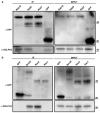Identification of GOLPH3 Partners in Drosophila Unveils Potential Novel Roles in Tumorigenesis and Neural Disorders
- PMID: 34571985
- PMCID: PMC8468827
- DOI: 10.3390/cells10092336
Identification of GOLPH3 Partners in Drosophila Unveils Potential Novel Roles in Tumorigenesis and Neural Disorders
Abstract
Golgi phosphoprotein 3 (GOLPH3) is a highly conserved peripheral membrane protein localized to the Golgi apparatus and the cytosol. GOLPH3 binding to Golgi membranes depends on phosphatidylinositol 4-phosphate [PI(4)P] and regulates Golgi architecture and vesicle trafficking. GOLPH3 overexpression has been correlated with poor prognosis in several cancers, but the molecular mechanisms that link GOLPH3 to malignant transformation are poorly understood. We recently showed that PI(4)P-GOLPH3 couples membrane trafficking with contractile ring assembly during cytokinesis in dividing Drosophila spermatocytes. Here, we use affinity purification coupled with mass spectrometry (AP-MS) to identify the protein-protein interaction network (interactome) of Drosophila GOLPH3 in testes. Analysis of the GOLPH3 interactome revealed enrichment for proteins involved in vesicle-mediated trafficking, cell proliferation and cytoskeleton dynamics. In particular, we found that dGOLPH3 interacts with the Drosophila orthologs of Fragile X mental retardation protein and Ataxin-2, suggesting a potential role in the pathophysiology of disorders of the nervous system. Our findings suggest novel molecular targets associated with GOLPH3 that might be relevant for therapeutic intervention in cancers and other human diseases.
Keywords: Drosophila; FMRP; GOLPH3; Golgi; cell cycle; male meiosis; spermatogenesis.
Conflict of interest statement
The authors declare no competing or financial interests.
Figures








Similar articles
-
Rab1 interacts with GOLPH3 and controls Golgi structure and contractile ring constriction during cytokinesis in Drosophila melanogaster.Open Biol. 2017 Jan;7(1):160257. doi: 10.1098/rsob.160257. Open Biol. 2017. PMID: 28100664 Free PMC article.
-
The roles of the oncoprotein GOLPH3 in contractile ring assembly and membrane trafficking during cytokinesis.Biochem Soc Trans. 2015 Feb;43(1):117-21. doi: 10.1042/BST20140264. Biochem Soc Trans. 2015. PMID: 25619256
-
GOLPH3 is essential for contractile ring formation and Rab11 localization to the cleavage site during cytokinesis in Drosophila melanogaster.PLoS Genet. 2014 May 1;10(5):e1004305. doi: 10.1371/journal.pgen.1004305. eCollection 2014 May. PLoS Genet. 2014. PMID: 24786584 Free PMC article.
-
GOLPH3: a Golgi phosphatidylinositol(4)phosphate effector that directs vesicle trafficking and drives cancer.J Lipid Res. 2019 Feb;60(2):269-275. doi: 10.1194/jlr.R088328. Epub 2018 Sep 28. J Lipid Res. 2019. PMID: 30266835 Free PMC article. Review.
-
GOLPH3 and oncogenesis: What is the molecular link?Tissue Cell. 2017 Apr;49(2 Pt A):170-174. doi: 10.1016/j.tice.2016.06.008. Epub 2016 Jun 17. Tissue Cell. 2017. PMID: 27378035 Review.
Cited by
-
GOLPH3 protein controls organ growth by interacting with TOR signaling proteins in Drosophila.Cell Death Dis. 2022 Nov 27;13(11):1003. doi: 10.1038/s41419-022-05438-9. Cell Death Dis. 2022. PMID: 36435842 Free PMC article.
-
GOLPH3 modulates expression and alternative splicing of transcription factors associated with endometrial decidualization in human endometrial stromal cells.PeerJ. 2023 Mar 20;11:e15048. doi: 10.7717/peerj.15048. eCollection 2023. PeerJ. 2023. PMID: 36967990 Free PMC article.
-
Microtubule and Actin Cytoskeletal Dynamics in Male Meiotic Cells of Drosophila melanogaster.Cells. 2022 Feb 16;11(4):695. doi: 10.3390/cells11040695. Cells. 2022. PMID: 35203341 Free PMC article. Review.
-
Next-generation large-scale binary protein interaction network for Drosophila melanogaster.Nat Commun. 2023 Apr 15;14(1):2162. doi: 10.1038/s41467-023-37876-0. Nat Commun. 2023. PMID: 37061542 Free PMC article.
-
Appraisal of CRISPR Technology as an Innovative Screening to Therapeutic Toolkit for Genetic Disorders.Mol Biotechnol. 2025 Feb 2. doi: 10.1007/s12033-025-01374-z. Online ahead of print. Mol Biotechnol. 2025. PMID: 39894889 Review.
References
-
- Dippold H.C., Ng M.M., Farber-Katz S.E., Lee S.K., Kerr M.L., Peterman M.C., Sim R., Wiharto P.A., Galbraith K.A., Madhavarapu S., et al. GOLPH3 bridges phosphatidylinositol-4- phosphate and actomyosin to stretch and shape the Golgi to promote budding. Cell. 2009;139:337–351. doi: 10.1016/j.cell.2009.07.052. - DOI - PMC - PubMed
-
- Sechi S., Colotti G., Belloni G., Mattei V., Frappaolo A., Giansanti M.G. GOLPH3 Is Essential for Contractile Ring Formation and Rab11 Localization to the Cleavage Site during Cytokinesis in Drosophila melanogaster. PLoS Genet. 2014;10:e1004305. doi: 10.1371/journal.pgen.1004305. - DOI - PMC - PubMed
Publication types
MeSH terms
Substances
Grants and funding
LinkOut - more resources
Full Text Sources
Medical
Molecular Biology Databases
Research Materials
Miscellaneous

